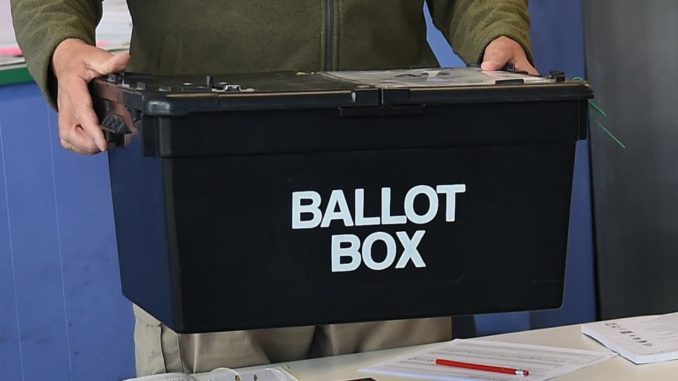
The public is being urged to take part in tomorrow’s “hugely significant” North Yorkshire local elections
The county’s electorate will go to the polls to decide the political make-up of the new unitary authority that will be launched in the spring of next year.
The councillors will serve the final year of North Yorkshire County Council and will then be the voice of the public for the first four years of the new over-arching single authority.
They will shape what public services will look like ahead of the launch of the new North Yorkshire Council on April 1, 2023, making decisions affecting the 600,000-strong population in the county.
The move to create the new authority, which will see the county council merged with the existing seven district councils, represents the biggest shake-up in local government in North Yorkshire since 1974, when the current structure of local government was introduced.
Richard Flinton, the county returning officer for the election who is also the chief executive of North Yorkshire County Council, said: “The election on May 5 is such an important day not just for how the new council will be shaped, but also for everyone who lives and works in North Yorkshire.
“This is an opportunity for everyone who is registered to vote to help decide on who they want to represent them at what is a defining moment for North Yorkshire.
“The importance of these elections is hugely significant, as it not only lays the foundations for the decision-makers for the new unitary authority, but it also paves the way for a devolution deal for North Yorkshire and York.”
The Government has stipulated that a key requirement for any devolution deal for North Yorkshire is for the current two-tier system of local government, with the county council and seven district councils, to be replaced by a single unitary authority.
City of York Council will continue as a unitary authority to run in tandem with the new North Yorkshire Council.
The deal to hand over decision-making powers and tens of millions of pounds in funding to political leaders in York and North Yorkshire is currently being negotiated with the Government, with an announcement on an offer for devolution expected this summer before public consultations are staged later in the year.
The local elections on May 5 will see 90 seats at stake for councillors on the new North Yorkshire Council spread across 89 electoral divisions. One of the divisions – Selby West – will have two members due to the size of its population.
A total of 310 candidates will contest the election, with the Conservative Party fielding candidates in all 90 seats, along with 67 Labour and Co-operative Party candidates, 48 Green Party candidates, 45 Liberal Democrats and 45 Independents. The remaining 15 candidates will be from a range of other smaller parties.
District and borough councils will remain until April 1, 2023, and the councillors serving on those local authorities will continue in their roles until that date.
There will be 14 divisions and 14 councillors in the current Hambleton area.
The divisions and candidates are:
Aiskew and Leeming
- Malcolm Chaloner – Green Party
- John Weighell – Consevative
Bedale
- Lenny Cornwall – Labour
- Elaine Kilroy – Green Party
- David Webster – Conservative
Easingwold
- Barry Doyle – Liberal Democrats
- Nigel Knapton – Conservative
- Emma Scott-Spivey – Labour
Great Ayton
- Heather Moorhouse – Conservative
- Mike Newton – Labour
- Richard Short – Liberal Democrats
Hillside and Raskelf
- Alyson Baker – Conservative
- Adam Harper – Green Party
- Andrew Robinson – Independent
- Ian Whitehead – Labour
Huby and Tollerton
- Neil Beckwith – Liberal Democrats
- Malcolm Taylor – Conservative
- Helen Tomlinson – Labour
Hutton Rudby and Osmotherley
- Bridget Fortune – Conservative
- David Hugill
- Anne Mannix – Labour
- Duncan Ross Russell – Liberal Democrats
Morton-on-Swale and Appleton Wiske
- Joseph Body – Labour
- Annabel Wilkinson – Conservative
- John Yorke – Green Party
Northallerton North and Brompton
- Paul Atkin – Independent
- James Grainge – Labour
- Steve Watson – Conservative
Northallerton South
- Paul Chapman – Liberal Democrats
- Caroline Dickinson – Conservative
- Gerald Ramsden – Labour
Romanby
- Mark Harrison – Liberal Democrats
- Joe Sawdon – Labour
- Peter Wilkinson – Conservative
Sowerby and Topcliffe
- Mark Robson – Conservative
- David Whitfield – Green Party
Stokesley
- Jack Cooper – Conservative
- Bryn Griffiths – Liberal Democrats
- Geoffrey Marron – Labour Party
Thirsk
- Gareth Dadd – Conservative
- Bill Hoult – Liberal Democrats
- David Seex – Labour
Measures have been taken to ensure that the safety of voters is paramount at polling stations in the wake of the Covid-19 pandemic.
Hand sanitiser will be available at the entrances to polling stations, which will be well-ventilated and areas that are touched frequently will be cleaned regularly throughout the day.
While rules governing the wearing of a face covering have been relaxed under national guidance, voters have been urged to consider wearing a covering while mixing with people they would not normally meet at polling stations.
National rules mean that it is no longer legally required to self-isolate if someone tests positive for Covid-19 or has symptoms. However, anyone who has tested positive or is displaying symptoms for the virus is also being advised to stay at home if possible and avoid contact with other people.
Polling stations will be open across the county from 7am until 10pm on May 5.
More details about the new electoral divisions and the May 5 county council elections are available at www.northyorks.gov.uk/elections


Be the first to comment